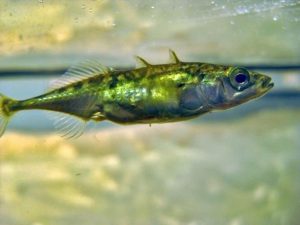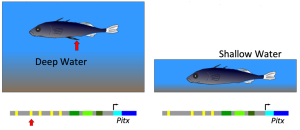Speciation
We can observe instances of mutation, genetic drift, natural selection, and gene flow by monitoring populations over time. But speciation – and the relationship of one species to another – must be inferred through comparison of the anatomy of extant and fossilized organisms. In the last few decades, however, genomic comparisons have become much more common in the analysis of evolutionary relationships.
For speciation to occur, two (or more) populations must be reproductively isolated from one another. For reproductive isolation, gene flow must be minimized between the populations, with each population separately subjected to mutation, natural selection, and genetic drift. While speciation generally happens on much too long a timescale to observe in real-time, we can see instances of microevolution that are likely steps in speciation.
One example is seen in the three-spine stickleback fish, Gasterosteus aculeatus, shown in Figure 9. These fish can live in both deep water and shallow water, but there are phenotypic differences between deep water and shallow water populations. Deep-water fish have an extra, spiny pelvic fin protruding from their ventral side, while shallow-water fish lack this ventral fin. It is thought that the pelvic fin is disadvantageous to the shallow-water fish since it might drag in shallow-water sediment and serve as an attachment point for parasitic insects like dragonfly larvae. The spiny pelvic fin is advantageous to the deep water fish, though, because it protects against predators.
A comparison of the genomes reveals the underlying genetics of these phenotypes: the pelvic fin seems to depend on an enhancer upstream of the Pitx (paired-like homeobox 1) gene. Pitx is expressed in certain clusters of cells during development, including the cells that eventually develop into the pelvic fin. The shallow-water fish carry a loss-of-function mutation in the enhancer. Although the Pitx is fully functional in the shallow-water fish and is expressed in other parts of the embryo, it is not expressed in the cells that would otherwise give rise to the pelvic spine.
These populations are reproductively isolated, and natural selection has favored fish either with or without the spiny fin, depending on the ecosystem. This has resulted in the divergence of these two populations. Some scientists think that the stickleback is in the early stages of speciation.


Figure 9. Deep water sticklebacks are reproductively isolated and are genotypically and phenotypically distinct.
Test your understanding
Media Attributions
- Figure 9. (right) Speciation © JaySo83 is licensed under a CC BY-SA (Attribution ShareAlike) license
- Figure 9. (left) Speciation © Open Genetics Lectures, Original-Deyholos is licensed under a CC BY-NC (Attribution NonCommercial) license

